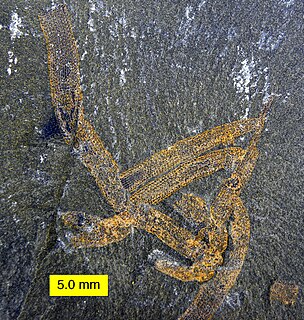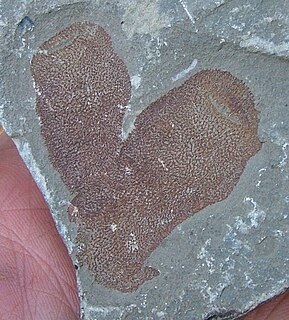
Vauxia is an extinct genus of demosponge that had a distinctive branching mode of growth. Each branch consisted of a network of strands. Vauxia also had a skeleton of spongin common to modern day sponges. Much like Choia and other sponges, Vauxia fed by extracting nutrients from the water.

Hazelia is a genus of spicular Cambrian demosponge known from the Burgess Shale, the Marjum formation of Utah, and possibly Chengjiang. It was described by Charles Walcott in 1920.
Leptomitus is a genus of demosponge known from the Middle Cambrian Burgess Shale. Its name is derived from the Greek lept ("slender") and mitos ("thread"), referring to the overall shape of the sponge. 138 specimens of Leptomitus are known from the Greater Phyllopod bed, where they comprise 0.26% of the community.
Wapkia is an extinct genus of sea sponge with radial sclerites, known from the Middle Cambrian Burgess Shale. It was first described in 1920 by Charles Doolittle Walcott. 32 specimens of Wapkia are known from the Greater Phyllopod bed, where they comprise 0.06% of the community.
Pseudoalteromonas spongiae is a marine bacterium isolated from the sponge Mycale adhaerens in Hong Kong.

Dictyonellidae is a family of sponges in the order Bubarida.
Streptomyces spongiae is a bacterium species from the genus of Streptomyces which has been isolated from the marine sponge Haliclona in Tateyama in Chiba in Japan.
Saccharopolyspora cebuensis is a bacterium from the genus Saccharopolyspora which has been isolated from the marine sponge Haliclona on Cebu in the Philippines.
Salinifilum ghardaiense is an extremely halophilic bacterium from the genus Salinifilum which has been isolated from sahara soil from Chaâbet Ntissa, M'zab, Ghardaïa Province, Algeria.
Saccharopolyspora halotolerans is a halophilic bacterium from the genus Saccharopolyspora which has been isolated from soil from the salt lake Lop Nur in Xinjiang in China.
Saccharopolyspora phatthalungensis is a bacterium from the genus Saccharopolyspora. It is closely related to Saccharopolyspora shandongensis and Saccharopolyspora spinosa, but was determined to be a unique species in 2010. It was collected by being isolated from rhizospheric soil from the tree Hevea brasiliensis in Phatthalung on Thailand.
Saccharopolyspora qijiaojingensis is a halophilic bacterium from the genus Saccharopolyspora which has been isolated from a salt lake in Xinjiang in China.
Saccharopolyspora shandongensis is a bacterium from the genus Saccharopolyspora which has been isolated from wheat field soil in Shandong in China.
Saccharopolyspora subtropica is a thermophilic bacterium from the genus Saccharopolyspora which has been isolated from a sugar cane field in Guangxi in China.
Mycale adhaerens, the purple scallop sponge, is a species of marine demosponge in the family Mycalidae. Mycale is a large genus and this species is placed in the subgenus Aegogropila making its full name, Mycale (Aegogropila) adhaerens. It grows symbiotically on the valves of scallop shells and is native to the west coast of North America.
Mangrovimonas spongiae is a Gram-negative, rod-shaped and motile bacterium from the genus of Mangrovimonas which has been isolated from a marine sponge from the Yangpu Bay in China.
Zhouia spongiae is a Gram-negative, rod-shaped and non-motile bacterium from the genus of Zhouia which has been isolated from a sponge from the Yangpu Bay on Hainan.
Dysidea etheria, commonly known as the ethereal sponge or heavenly sponge, is a species of lobate sponge within the class Demospongiae. This marine sponge is known for its light blue color and can be found in the Caribbean as well as off the coasts of Florida and Georgia. Like all other poriferans, D. etheria is capable of both sexual and asexual reproduction. The use of spicule collection as well as chemical defenses allows D. etheria to protect itself against predators such as the zebra doris and the orange knobby star. D. etheria is also known as a host species of the invasive brittle star Ophiothela mirabilis. Lastly, various molecular biology studies have utilized D. etheria to both study foreign particle transport in sponges and to isolate novel molecules.
Nonlabens spongiae is a Gram-negative, strictly aerobic, rod-shaped and motile bacterium from the genus of Nonlabens which has been isolated from a marine sponge from the Bahamas.


